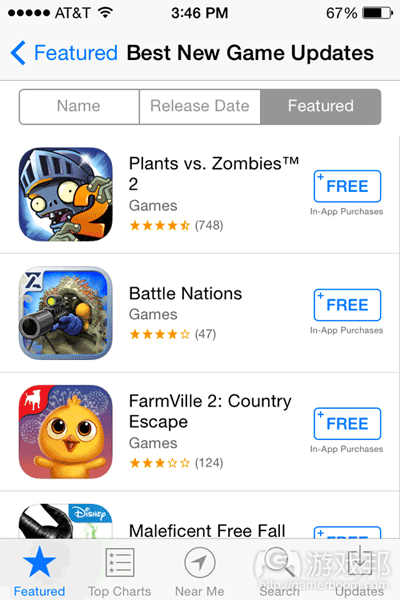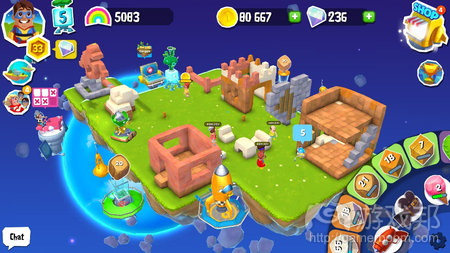每日观察:关注开发者的用户获取方式调查(6.27)
1)据gamasutra报道,移动顾问Adam S.Gutterman日前发布推文指出,他发现苹果App Store推出了一个新版块“最新游戏更新”,支持用户根据3项标准来寻找活跃更新内容的游戏,以帮助解决应用商店曝光度不足的问题。
2)据Venturebeat针对230名开发者(覆盖9000款应用和将近4亿月活跃用户)的调查报告显示,最不受开发者欢迎的用户获取方法往往却最具盈利性。而最受其青睐的方法却最不可能带来高质量的用户。
报告指出,每安装成本(CPI)是手机开发者最喜欢的用户获取广告模式,有52%开发者首先选择这一方法,其比例甚至是排名第二的用户获取方法的两倍以上。这可能是与其简便性和安全性有关:如果每获取成本低于用户终身价值,开发者就会采取行动。
但通过这种CPI方法获取的用户往往价值极低,超过三分之二用户的终身价值(LTV)不足10美元,几乎每6名用户中就有一者的LTV为0。
而其他三种用户获取方法却能够以较低成本获取质量更高的用户,例如CPL(cost-per-lead)就能够产生每年创收超过75美元的高质量“鲸鱼用户”,尽管开发者对其使用率比其他方法低10倍左右。
尽管Facebook目前是对手机开发者用户获取营销活动贡献最大的公司,但谷歌和YouTube才是这些开发者最欢迎的用户获取合作伙伴。
在Venturebeat调查的75家用户获取营销公司中,NativeX、Fiksu、Chartboost、Flurry以及最近被收购的AdColony表现不相上下并且超越了其他竞争者,它们所收获的反馈数据堪比YouTube和Twitter。
3)据gamasutra报道,任天堂最近在日本京都总部附近新成立了一个产品开发中心,以便管理层更密切地参与硬件和软件开发项目。
报道称这个产品开发大楼成本约190亿日元(1.863亿美元),将专注制造次世代设备的新硬件和软件。
4)据Eurogamer报道,Crytek公司在英国匿名知情人日前透露,公司自2011年以来就已经无法按时为所有员工发出工资,导致团队士气低落,已有30多名员工离职。
除此之外,报道还指出Crytek最近还驳斥了德国杂志Gamestar关于该公司濒临破产的说法。Kotaku跟进的报道也声称,Crytek因失去与微软合作开发Xbox One游戏《Ryse》续作的协议而导致无法为员工支付薪水,有知情者透露,Crytek禁止员工在电子邮件讨论发薪问题,有一名前Crytek员工也向Kotaku证实了这些说法和传闻。
5)据gamasutra报道,世嘉公司在本月初向投资者表示,公司免费手机RPG《Chain Chronicles》自去年7月份在iOS和Android平台发布以来的9个月中,其销售额已超过73亿日元(约7200万美元),并计划在本财年发布30款新免费游戏。
这些新游戏中将至少有两款《Chain Chronicle》续作,并将面向PS Vita平台开发免费版本的《Chain Chronicle V》。
6)据venturebeat报道,芬兰工作室Grand Cru日前终于发布其备受关注的3D手机游戏《Supernauts》,并声称这是“史上最富雄心的iPhone、iPad和iPod Touch游戏”。观察者称从其预告视频来看,这一点的确不可否认,但其游戏玩法究竟能否持续吸引玩家则有待时间考证。
Grand Cru由包括Markus Pasula在内的8名手机游戏行业先锋组建,曾融资超过1600万美元,目前有35名员工;据Pasula所称,他们历时2年完善这款游戏在iPad平台上的玩法体验,并确信其人性化的用户界面有利于人们享受这种在3D环境中创造世界的乐趣。(本文为游戏邦/gamerboom.com编译,拒绝任何不保留版权的转载,如需转载请联系:游戏邦)
1)Apple gives a boost to iOS devs with ‘Best New Game Updates’
By Christian Nutt
Developers have long complained that the iOS App Store doesn’t offer enough avenues for players to find games. Today, Apple has added a new discovery tool to its App Store with “Best New Game Updates” — which should help players connect with games that are actively being worked on.
The update first came to Gamasutra’s attention thanks to this tweet by mobile consultant Adam S. Gutterman. You can see a shot taken from the live App Store of the new section below, which allows users to sort the updates according to three criteria.
Discoverability has been a primary concern for mobile developers for years — and platform-holders have been slow to make changes to their store environments in response. Earlier this month, at its annual WWDC conference, Apple announced that further discoverability features are slated to come with this fall’s iOS 8 release.
For its part, Google’s Greg Hartnell told Gamasutra yesterday that its Google Play Games service and SDK — which works on both iOS and Android — is tailored to increasing player engagement and game discoverability. (source:gamasutra)
2)Study: 9K apps and 397M users show cost-per-install is the worst mobile user acquisition method
John Koetsier
Above: A full third of developers get cheated when trying to acquire users
And it gets even more unfortunate, as most developers are doing it wrong.
In a 230-developer study that covers over 9,000 apps and almost 400 million monthly active users, VentureBeat has learned that developers’ least-favorite user-acquisition method is often the most financially successful. In addition, the most-favored is also the least likely to bring in the best high-quality users.
And while Facebook and Google are the undisputed king and queen of user acquisition, five other companies tower above the dozens of other user-acquisition competitors.
Get the full VB Mobile User Acquisition study on VB Insight
The app marketer’s challenge is clear: With 98 percent of revenue coming from freemium apps, finding the right users is critical to whether an app lives or dies. Entice users who pay for premium upgrades or in-app purchases and you’ll live.
Fail and you’ll die.
Making the whole game more complex is untrustworthy user acquisition companies — a full third of developers in our study report getting cheated when working with one of these firms.
According to the app and game makers we surveyed, cost-per-install is the mobile developer’s runaway favorite advertising mode for user acquisition.
Above: The mostly commonly used user-acquisition methods.
In fact, 52 percent of developers choose CPI first, more than double the number of the next-leading method. That’s probably due to its sheer simplicity: If the cost-per-acquisition is lower than your user lifetime value, you pull the trigger. For the same reason, it’s also very safe … you know exactly what your costs are going to be, and if they fit within your app’s economics, nothing can go wrong.
(Theoretically, of course — assuming you’re right about your customer lifetime value.)
The problem is that most of the users you acquire via CPI are astonishingly low-value. Over two-thirds of the users you acquire via CPI have sub-$10 LTV, and almost one in six have profitability-dooming LTV of precisely zero.
Above: 70% of developers use social media to acquire users
Three other user-aquisition methodologies, regardless of user acquisition company or partner, generate better users at a lower price, including cost-per-lead (CPL), which generates just as many high-value “whales” who spend more than $75/year in your app despite being used by 10 times less frequently.
While Facebook is by far the biggest contributor to mobile developers’ user acquisition campaigns, Google plus YouTube actually beats Facebook for first place as the most-preferred user acquisition partner.
In the crowded user acquisition marketplace, however, where we counted easily 75 competitors, five companies stood head-and-shoulders above the rest. In fact, NativeX, Fiksu, Chartboost, Flurry, and the recently acquired AdColony all tower above their competition, with cumulative response numbers comparable to YouTube and Twitter.(source:venturebeat)
3) New Nintendo development center opens in Kyoto
By Mike Rose
Nintendo has opened a new product development building in Kyoto near its headquarters, as management looks to interact more closely with hardware and software developments.
As reported by Kyoto NP, and as translated by Nintendo Everything, this new building cost around 19 billion yen ($186.3 million), and will focus on produce new hardware and software for the next-generation.
“We’ll be interacting more deeply with hardware development, but we’ll also be able to develop integrated software,” noted Nintendo president Satoru Iwata. (source:gamasutra)
4) Report: Crytek losing staff and failing to meet payroll
By Alex Wawro
A pair of reports published this week by Eurogamer and Kotaku suggest that CryEngine developer Crytek may be having trouble paying all of its employees, losing some of them in the process.
According to Eurogamer, anonymous sources within Crytek UK claim the company has failed to consistently meet payroll for all employees, leading to low morale and the departure of more than 30 staff members since 2011.
The report is a follow-up to Crytek’s recent statement refuting German magazine Gamestar’s accusation that the company is on the verge of bankruptcy.
Kotaku’s Jason Schreier has also been following the story for some time, and published a report today claiming that Crytek has had trouble paying all of its employees after losing a deal with Microsoft to develop a sequel to the studio’s Xbox One launch game Ryse. According to a number of Schreier’s sources, Crytek employees have been expressly forbidden from discussing salary issues over email.
“It upsets me greatly that Crytek continues to deny these allegations,” reads one email from an anonymous former Crytek employee cited by Kotaku. “They are all true!”
Gamasutra has reached out to Crytek for comment, and we’ll update this story with any meaningful new information.
If you or someone you know has been affected by this situation, you can email Gamasutra to tell your story confidentially. (source:gamasutra)
5)Sega reaped over $72M in sales from one F2P mobile game last year
By Alex Wawro
Newsbrief: Last month we reported that Sega parent company Sega Sammy Holdings was focusing its business on free-to-play mobile games, and now we know why: that’s where the company is making a sizable chunk of its money.
According to a strategic planning presentation disclosed to investors earlier this month, Sega’s free-to-play mobile RPG Chain Chronicles reaped over 7.3 billion yen (~$72 million USD) in sales for the company across iOS and Android in the nine months following its launch last July.
That’s remarkable financial performance for a mobile game, and it helps explain why the company is planning to launch 30 new free-to-play titles in the current fiscal year.
At least two of those will be Chain Chronicle games, as the company plans to capitalize on game’s success by releasing a sequel on mobile and developing the free-to-play PlayStation Vita game Chain Chronicle V based on the original mobile hit.(source:gamasutra)
6)Grand Cru finally launches social world-builder Supernauts — bills it as ‘most ambitious iPhone, iPad, and iPod Touch game of all time’
Dean Takahashi
More than two years in the making, Supernauts has launched on iOS today as a new entry in the world-building genre that Minecraft pioneered.
The Helsinki, Finland-based Grand Cru development house has attracted a lot of attention and funding for the cartoon-like 3D title, which the company bills as the “most ambitious iPhone, iPad, and iPod Touch game of all time.” And looking at the trailers, you can’t really argue with that. Now the big question is whether the gameplay is fun enough to keep players coming back to the free-to-play game.
If the game succeeds, it will be one more example of how Finland is home to the premier mobile game hubs of the smartphone and tablet era. Other prime example’s of Helsinki’s success include Rovio, the maker of Angry Birds, and Supercell, which created Hay Day and Clash of Clans (one of the biggest money-making mobile games of all time). Apple is featuring Supernauts on the Apple iTunes App Store today.
Supernauts is set in a cartoon world of the future where the polar ice caps have melted and the player has to build a new habitat for humans on asteroids in space. You build use touchscreen controls to build 3D objects and characters. And while you are doing it, other players can join in, helping you create items in the same 3D space. The worlds are limited in size and scope, based on the size of the asteroid. But you can build on multiple asteroids. There are already more than 50 missions where players can rescue humans on Earth.
“Grand Cru is a game studio focused on developing groundbreaking mobile games of the finest quality and we’re aiming to revolutionize social gaming with Supernauts,” said Markus Pasula, the CEO of Grand Cru. “Created for a broad audience, the game is truly social and provides players with multiple ways to share their creations and experiences. We want to take real-time social interactions in mobile gaming in to another level.”
In the progression trailer below, you can see how quickly players can build amazing worlds in a relatively short time. In one to two days, you can have your own little village in space. And within weeks, you can have a unique custom world that reflects your own creativity. Players can create themed worlds in worldwide contests. Players can also set up teams to compete against other teams in tournaments.
“We have spent over two years perfecting the gameplay experience for the iPad, and we are certain that with our intuitive user interface everyone will be able to join the fun of creating awesome worlds in 3D,” Pasula said.
Eight pioneers of mobile gaming, including Pasula, founded Grand Cru in 2011. The company has raised more than $16 million to date from Idinvest Partners, Qualcomm Ventures, Nokia Growth Partners, Signia Venture Partners and Lifeline Ventures. Grand Cru has 35 employees.(source:venturebeat)












































 闽公网安备35020302001549号
闽公网安备35020302001549号